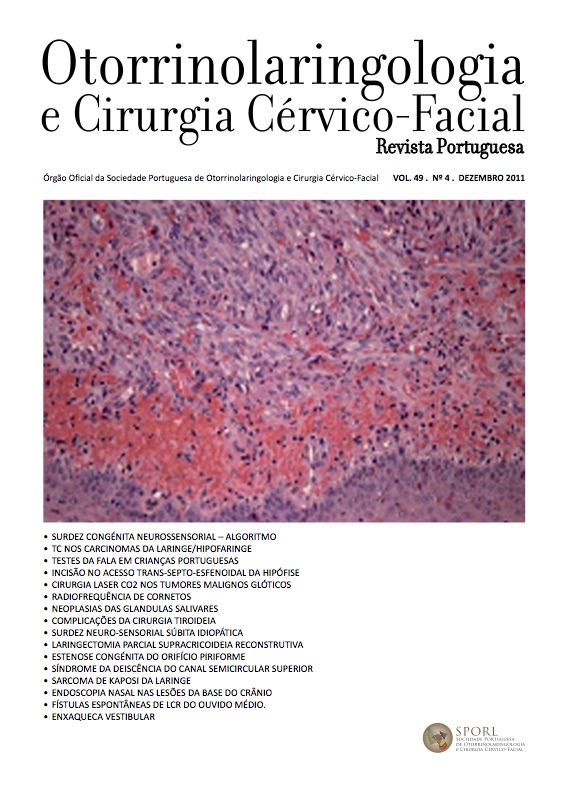Superior semicircular canal dehiscence syndrome: Two cases report.
DOI:
https://doi.org/10.34631/sporl.200Keywords:
superior semicircular canal dehiscence, conductive hearing loss, vertigo, vestibular evoked myogenic potentialAbstract
The Superior Semicircular Canal Dehiscence Syndrome (SSCDS) has been characterized by vestibular symptoms induced by loud sound (Tullio phenomenon) or stimuli that change middle ear or intracranial pressure, and conductive hearing loss. The autors present the case report of 2 female patients:
• 44 years-old, referring left hearing loss and tinnitus with vertigo; the observation revealed bilateral conductive hearing loss with a left larger air-bone gap in low frequencies and type A tympanogram with normal acoustic stapedial reflex; the vestibular evoked myogenic potential (VEMP) and computed tomography (CT) confirmed superior semicircular canal dehiscence. The patient was submitted to surgery to repair the bone dehiscence. One month after surgery, she presented vestibular symptoms improvement;
• 57 years-old, who presents vertigo and chronic dysequilibrium complaints, with no hearing loss; the observation revealed normal audiometry and normal impedance, the videonystagmography showed right hyporeflexia and electrococleography had no labyrinthine hydrops criteria; VEMP and CT confirmed superior semicircular canal dehiscence.
Downloads
References
Ferreira SC, Lima MA. Síndrome de Deiscência de Canal Semicircular Superior. Rev Bras Otorrinolaringol. 2006 Jun;72(3):414-8.
Lehmann M, Ebmeyer J, Upile T, Sudhoff HH. Superior canal dehiscence in a patient with three failed stapedectomy operations
for otosclerosis: a case report. Journal of Medical Case Reports. 2011;5:47-9.
Crane BT, Carey JP, Minor LB. Superior Semicircular Canal Dehiscence Syndrome. In: Brackmann DE, Shelton C, Arriaga MA (Eds.) Otologic
Surgery, Philadelphia, Saunders Elsevier; 2010:pp507-18.
Carey JP, Minor LB, Nager GT. Dehiscence or thining of bone overlying the superior semicircular canal in a temporal bone survey.
Arch Otolaryngol Head Neck Surg. 2000;126:137-47.
Minor LB. Superior canal dehiscence syndrome. Am J Otol. 2000;21(1):9-19.
Mikulec AA, McKenna MJ, Ramsey MJ, Rosowski JJ, et al. Superior semicircular canal dehiscence presenting as conductive hearing loss
without vertigo. Otol Neurotol. 2004;25(2):121-9.
Hirvonen TP, Weg N, Zinreich SJ, Minor LB. High-resolution CT findings suggest a developmental abnormality underlying superior
canal dehiscence syndrome. Acta Otolaryngol. 2003;123(4):477-81.
Minor LB. Clinical manifestations of superior semicircular canal dehiscence. Laryngoscope. 2005;115:1717-27.
Merchant SN, Rosowski JJ, McKenna MJ. Superior Semicircular Canal Dehiscence Mimicking Otosclerotic Hearing Loss. Adv
Otorhinolaryngol. 2007;65:137-45.
Murofushi T, Kaga K. Superior Canal Dehiscence Syndrome and VEMPs: Detection of Hypersensitivity of the Vestibular System to
Sound. In: Murofushi T, Kaga K (Eds.) Vestibular Evoked Myogenic Potential: Its Basics and Clinical Applications, Tokio, Springer;
:pp73-77.
Cremer PD, Minor LB, Carey JP, Della Santina CC. Eye movements in patients with superior canal dehiscence syndorme align with the
abnormal canal. Neurology. 2000; 55:1833-41.
Halmagyi GM, Aw ST, MacGarvie La, et al. Superior semicircular canal dehiscence simulating otosclerosis. J Laryngol Otol.
;117:553-7.
Colebatch JG, Day BL, Brostein AM, et al. Vestibular hypersensitivity to clicks is characteristic of the Tullio phenomenon. J Neurol Neurosurg
Psychiatry. 1998;65:670-8.
Zhou G, Gopen Q, Poe DS. Clinical and diagnostic characterization of canal dehiscence syndrome: a great otologic mimicker. Otol
Neurotol. 2007;28(7):920-6.
Ramsey MJ, MacKenna MJ, Barker FG. Superior semicircular canal dehiscence syndrome. Case report. J Neurosurg. 2004;100(1):123-4.
Martin JE, Neal CJ, Monacci WT, Eisenman DJ. Superior semicircular canal dehiscence: a new indication for middle fossa craniotomy. Case
report. J Neurosurg. 2004;100(1):125-7.
Mikulec AA, McKenna MJ, Ramsey MJ, Rosowski JJ, et al. Superior semicircular canal dehiscence presenting as conductive hearing loss
without vertigo. Otol Neurotol. 2004 Mar;25(2):121-9.
Hope A, Fagan P. Latent superior canal dehiscence syndrome unmasked by stapedotomy for otosclerosis. J Laryngol Otol. 2010
Apr;124(4):428-30.
Vlastarakos PV, Proikas K, Tavourali E, Kikidis D, et al. Efficacy assessment and complications of surgical management for
superior semicircular canal dehiscence: a meta-analysis of published interventional studies. Eur Arch Otorhinolaryngol. 2009
Feb;266(2):177-86.
Crane BT, Lin FR, Minor LB, Carey JP. Improvement in autophony symptoms after superior canal dehiscence repair. Otol Neurotol. 2010
Jan;31(1):140-6.
Limb CJ, Carey JP, Srireddy S, Minor LB. Auditory function in patients with surgically treated superior semicircular canal dehiscence. Otol
Neurotol. 2006 Oct;27(7):969-80.






